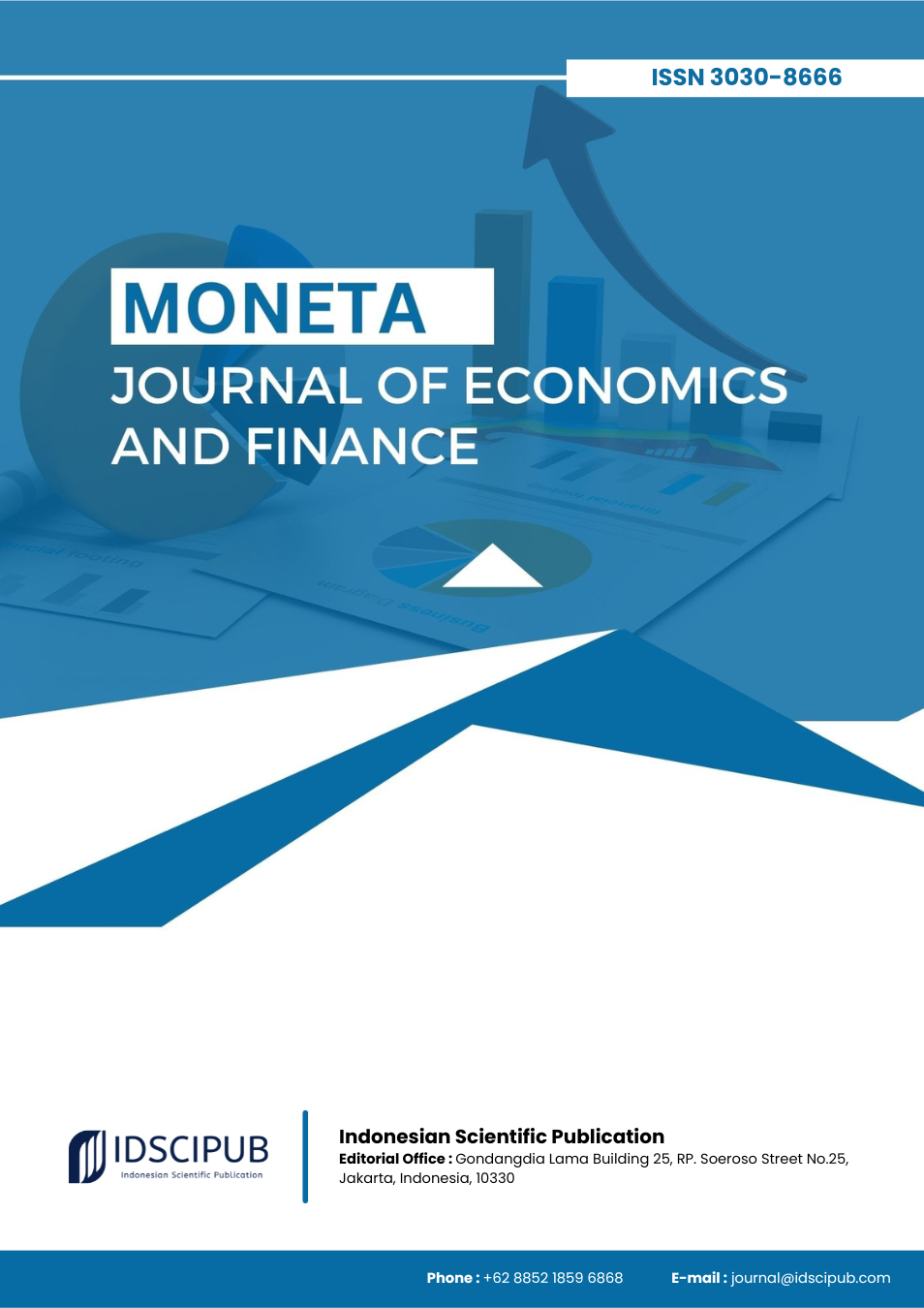Financial Inclusion, Stability, and Governance in the Era of Digital Currencies
DOI:
https://doi.org/10.61978/moneta.v3i4.929Keywords:
Central Bank Digital Currency, Cryptocurrency Regulation, Financial Inclusion, Monetary Policy, Blockchain Technology, Financial Stability, Digital FinanceAbstract
Digital currencies, including Central Bank Digital Currencies (CBDCs), cryptocurrencies, and stablecoins, are reshaping global financial systems, raising questions about efficiency, inclusion, stability, and regulation. This study aims to provide a narrative review of the opportunities and regulatory impacts of digital currencies within both advanced and emerging economies. Relevant literature was collected from major databases, including Scopus, Web of Science, Google Scholar, IEEE Xplore, and PLOS ONE. Selection emphasized relevance, quality, and contribution to technological, economic, and policy discussions. The results show that CBDCs offer opportunities to enhance financial inclusion and reduce transaction costs, while also strengthening monetary policy effectiveness. Cryptocurrencies and blockchain-based systems have demonstrated efficiency in cross-border transactions but also exhibit volatility and speculative behavior that challenge traditional financial theories. Regulatory frameworks and governance emerge as central issues, with evidence that clear, harmonized, and innovation-friendly regulations accelerate adoption, whereas restrictive policies hinder development. Global comparisons reveal that advanced economies emphasize monetary policy and stability, while developing economies prioritize inclusion. Systemic factors such as infrastructure, literacy, and governance strongly influence adoption outcomes. The findings underscore the urgency of adaptive regulation, international cooperation, and public education as strategies to maximize benefits while mitigating risks. Future research should explore sociopolitical and behavioral aspects, long-term systemic impacts, and regional variations to advance a comprehensive understanding of digital currencies. These insights provide critical guidance for policymakers and financial institutions navigating the digital transformation of money.
References
Antar, M. (2024). Quantile analysis of bitcoin returns: uncovering market dynamics. The Journal of Risk Finance, 26(1), 122-146. https://doi.org/10.1108/jrf-05-2024-0154 DOI: https://doi.org/10.1108/JRF-05-2024-0154
Attarde, K., Jaiswal, C., Khatwani, R., Pinto, G., & Kumar, V. (2024). A novel central bank digital currency framework design for offline and foreign transactions based on blockchain. Digital Policy Regulation and Governance, 27(2), 201-220. https://doi.org/10.1108/dprg-10-2023-0146 DOI: https://doi.org/10.1108/DPRG-10-2023-0146
Balijepalli, N. and Thangaraj, V. (2025). Prediction of cryptocurrency’s price using ensemble machine learning algorithms. European Journal of Management and Business Economics. https://doi.org/10.1108/ejmbe-08-2023-0244 DOI: https://doi.org/10.1108/EJMBE-08-2023-0244
Ballis, A., Δράκος, Κ., Kallandranis, C., Anastasiou, D., & Doan, V. (2025). The impact of covid-19 first wave on cryptocurrencies and g7 stock markets. Journal of Small Business and Enterprise Development. https://doi.org/10.1108/jsbed-12-2023-0582 DOI: https://doi.org/10.1108/JSBED-12-2023-0582
Boido, C. and Aliano, M. (2025). The contribution of cryptocurrencies to portfolio diversification. Investment Management and Financial Innovations, 22(2), 26-35. https://doi.org/10.21511/imfi.22(2).2025.03 DOI: https://doi.org/10.21511/imfi.22(2).2025.03
Bouri, E., Gabauer, D., Gupta, R., & Tiwari, A. (2021). Volatility connectedness of major cryptocurrencies: the role of investor happiness. Journal of Behavioral and Experimental Finance, 30, 100463. https://doi.org/10.1016/j.jbef.2021.100463 DOI: https://doi.org/10.1016/j.jbef.2021.100463
Cesaratto, S. and Febrero, E. (2023). Central bank digital currencies: a proper reaction to private digital money?. Review of Keynesian Economics, 11(4), 529-553. https://doi.org/10.4337/roke.2023.04.05 DOI: https://doi.org/10.4337/roke.2023.04.05
Chinthapalli, U. (2021). A comparative analysis on probability of volatility clusters on cryptocurrencies, and forex currencies. Journal of Risk and Financial Management, 14(7), 308. https://doi.org/10.3390/jrfm14070308 DOI: https://doi.org/10.3390/jrfm14070308
Chiu, J. and Davoodalhosseini, S. (2023). Central bank digital currency and banking: macroeconomic benefits of a cash-like design. Management Science, 69(11), 6708-6730. https://doi.org/10.1287/mnsc.2021.02763 DOI: https://doi.org/10.1287/mnsc.2021.02763
Davlatov, E. and Sági, J. (2025). The transmission mechanism of monetary policy and central bank digital currency: a new monetary order?. Journal of Central Banking Theory and Practice, 14(1), 95-119. https://doi.org/10.2478/jcbtp-2025-0006 DOI: https://doi.org/10.2478/jcbtp-2025-0006
de-la-Rica-Escudero, A., Garrido-Merchán, E., & Vaca, M. (2025). Explainable post hoc portfolio management financial policy of a deep reinforcement learning agent. Plos One, 20(1), e0315528. https://doi.org/10.1371/journal.pone.0315528 DOI: https://doi.org/10.1371/journal.pone.0315528
Elamine, M. and Abdallah, A. (2025). Predicting cryptocurrency prices with a hybrid arima and lstm model. Journal of Telecommunications and the Digital Economy, 13(1), 98-117. https://doi.org/10.18080/jtde.v13n1.1052 DOI: https://doi.org/10.18080/jtde.v13n1.1052
Fantacci, L. and Gobbi, L. (2021). Stablecoins, central bank digital currencies and us dollar hegemony. Accounting Economics and Law - A Convivium, 14(2), 173-200. https://doi.org/10.1515/ael-2020-0053 DOI: https://doi.org/10.1515/ael-2020-0053
Fernández, M., Alonso, S., Jorge-Vázquez, J., & Forradellas, R. (2021). Central banks’ monetary policy in the face of the covid-19 economic crisis: monetary stimulus and the emergence of cbdcs. Sustainability, 13(8), 4242. https://doi.org/10.3390/su13084242 DOI: https://doi.org/10.3390/su13084242
Galvão, R., Varela, J., & Dias, R. (2024). Multifractal behavior of cryptocurrencies during periods of economic uncertainty. Revista De Gestão Social E Ambiental, 18(3), e06616. https://doi.org/10.24857/rgsa.v18n3-107 DOI: https://doi.org/10.24857/rgsa.v18n3-107
Haq, I., Ferreira, P., Quintino, D., Huynh, N., & Samantreeporn, S. (2023). Economic policy uncertainty, energy and sustainable cryptocurrencies: investigating dynamic connectedness during the covid-19 pandemic. Economies, 11(3), 76. https://doi.org/10.3390/economies11030076 DOI: https://doi.org/10.3390/economies11030076
HAYKIR, Ö. and Yağlı, İ. (2022). Speculative bubbles and herding in cryptocurrencies. Financial Innovation, 8(1). https://doi.org/10.1186/s40854-022-00383-0 DOI: https://doi.org/10.1186/s40854-022-00383-0
Horváth, G. (2022). Monetary sovereignty and central bank digital currency. Pénzügyi Szemle = Public Finance Quarterly, 67(4), 539-552. https://doi.org/10.35551/pfq_2022_4_4 DOI: https://doi.org/10.35551/PFQ_2022_4_4
Huang, Y. and Mayer, M. (2022). Digital currencies, monetary sovereignty, and u.s.–china power competition. Policy & Internet, 14(2), 324-347. https://doi.org/10.1002/poi3.302 DOI: https://doi.org/10.1002/poi3.302
Kasana, E. and Singh, V. (2024). Central bank digital currency (cbdc) implementation in india., 98-120. https://doi.org/10.4018/979-8-3693-2061-7.ch005 DOI: https://doi.org/10.4018/979-8-3693-2061-7.ch005
Khanna, K., Ruhlan, S., Yadav, D., & Paul, D. (2024). Exploring digital currency adoption in india., 87-103. https://doi.org/10.4018/979-8-3693-3282-5.ch006 DOI: https://doi.org/10.4018/979-8-3693-3282-5.ch006
Kyriazis, Ν., Papadamou, S., Tzeremes, P., & Corbet, S. (2023). The differential influence of social media sentiment on cryptocurrency returns and volatility during covid-19. The Quarterly Review of Economics and Finance, 89, 307-317. https://doi.org/10.1016/j.qref.2022.09.004 DOI: https://doi.org/10.1016/j.qref.2022.09.004
Lee, E. (2025). Advancing digital economy and financial inclusion through central bank digital currencies: a comprehensive analysis of policies and legal implications through e-cny and enaira. African Journal of International and Comparative Law, 33(1), 1-28. https://doi.org/10.3366/ajicl.2025.0510 DOI: https://doi.org/10.3366/ajicl.2025.0510
Mnif, E., Mouakhar, K., & Jarboui, A. (2022). The co‐movements of faith‐based cryptocurrencies in periods of pandemics. Review of Financial Economics, 40(3), 300-311. https://doi.org/10.1002/rfe.1154 DOI: https://doi.org/10.1002/rfe.1154
Morgan, J. (2023). Systemic stablecoin and the brave new world of digital money. Cambridge Journal of Economics, 47(1), 215-260. https://doi.org/10.1093/cje/beac060 DOI: https://doi.org/10.1093/cje/beac060
Morales-Urrutia, X. and Pillajo, V. (2025). Bitcoin volatility: a profitability-focused approach. Data & Metadata, 3. https://doi.org/10.56294/dm2024.208 DOI: https://doi.org/10.56294/dm2024.208
Motamri, W. and Trimech, A. (2025). Social media's influence on cryptocurrency investments: environmental awareness and market dynamics. Wseas Transactions on Business and Economics, 22, 822-831. https://doi.org/10.37394/23207.2025.22.72 DOI: https://doi.org/10.37394/23207.2025.22.72
Özdemir, O. (2022). Cue the volatility spillover in the cryptocurrency markets during the covid-19 pandemic: evidence from dcc-garch and wavelet analysis. Financial Innovation, 8(1). https://doi.org/10.1186/s40854-021-00319-0 DOI: https://doi.org/10.1186/s40854-021-00319-0
Păuna, C. (2019). Low risk trading algorithm based on the price cyclicality function for capital markets. Management & Marketing, 14(1), 80-89. https://doi.org/10.2478/mmcks-2019-0006 DOI: https://doi.org/10.2478/mmcks-2019-0006
Pelster, M., Breitmayer, B., & Hasso, T. (2019). Are cryptocurrency traders pioneers or just risk-seekers? evidence from brokerage accounts. Economics Letters, 182, 98-100. https://doi.org/10.1016/j.econlet.2019.06.013 DOI: https://doi.org/10.1016/j.econlet.2019.06.013
Petti, D. and Sergio, I. (2024). Bank crisis boosts bitcoin price. Journal of Risk and Financial Management, 17(4), 134. https://doi.org/10.3390/jrfm17040134 DOI: https://doi.org/10.3390/jrfm17040134
Qureshi, K. and Zaman, T. (2023). Social media engagement and cryptocurrency performance. Plos One, 18(5), e0284501. https://doi.org/10.1371/journal.pone.0284501 DOI: https://doi.org/10.1371/journal.pone.0284501
Ridwan, E., Wahyuni, M., & Salim, D. (2025). Cbdc news sentiment on the stock market and cryptocurrencies. International Journal of Innovative Research and Scientific Studies, 8(1), 2688-2698. https://doi.org/10.53894/ijirss.v8i1.5043 DOI: https://doi.org/10.53894/ijirss.v8i1.5043
Sawhney, R., Agarwal, S., Mittal, V., Rosso, P., Nanda, V., & Chava, S. (2022). Cryptocurrency bubble detection: a new stock market dataset, financial task & hyperbolic models.. https://doi.org/10.18653/v1/2022.naacl-main.405 DOI: https://doi.org/10.18653/v1/2022.naacl-main.405
Shrotryia, V. and Kalra, H. (2021). Herding in the crypto market: a diagnosis of heavy distribution tails. Review of Behavioral Finance, 14(5), 566-587. https://doi.org/10.1108/rbf-02-2021-0021 DOI: https://doi.org/10.1108/RBF-02-2021-0021
Sonkurt, H. and Altınöz, A. (2021). Cryptocurrency investment: a safe venture or a new type of gambling?. Journal of Gambling Issues, (47). https://doi.org/10.4309/jgi.2021.47.8 DOI: https://doi.org/10.4309/jgi.2021.47.8
Sundarasen, S. and Saleem, F. (2025). From tweets to trades: a bibliometric and systematic review of social media’s influence on cryptocurrency. International Journal of Financial Studies, 13(2), 87. https://doi.org/10.3390/ijfs13020087 DOI: https://doi.org/10.3390/ijfs13020087
Tanrikulu, H. and Pabuçcu, H. (2025). The effect of data types’ on the performance of machine learning algorithms for cryptocurrency prediction. Computational Economics. https://doi.org/10.1007/s10614-025-10919-y DOI: https://doi.org/10.1007/s10614-025-10919-y
Tripathy, N., Mishra, D., Hota, S., Mishra, S., Das, G., Dalai, S., … & Nayak, S. (2025). Bitcoin volatility forecasting: a comparative analysis of conventional econometric models with deep learning models. International Journal of Electrical and Computer Engineering (Ijece), 15(1), 614. https://doi.org/10.11591/ijece.v15i1.pp614-623 DOI: https://doi.org/10.11591/ijece.v15i1.pp614-623
Vardar, G. and Aydoğan, B. (2019). Return and volatility spillovers between bitcoin and other asset classes in turkey. Euromed Journal of Business, 14(3), 209-220. https://doi.org/10.1108/emjb-10-2018-0066 DOI: https://doi.org/10.1108/EMJB-10-2018-0066
Veloso, V., Gatsios, R., Magnani, V., & Lima, F. (2025). Is bitcoin’s market maturing? cumulative abnormal returns and volatility in the 2024 halving and past cycles. Journal of Risk and Financial Management, 18(5), 242. https://doi.org/10.3390/jrfm18050242 DOI: https://doi.org/10.3390/jrfm18050242
Yadav, M. (2024). Behavioral biases of cryptocurrency investors: a prospect theory model to explain cryptocurrency returns. Review of Behavioral Finance, 16(4), 643-667. https://doi.org/10.1108/rbf-07-2023-0172 DOI: https://doi.org/10.1108/RBF-07-2023-0172
Yadav, M. (2025). Intraday lottery demands in cryptocurrency market. Studies in Economics and Finance. https://doi.org/10.1108/sef-07-2024-0461 DOI: https://doi.org/10.1108/SEF-07-2024-0461
Yaâla, S. and Henchiri, J. (2025). Climate risks and cryptocurrency volatility: evidence from crypto market crisis. China Finance Review International. https://doi.org/10.1108/cfri-09-2024-0575 DOI: https://doi.org/10.1108/CFRI-09-2024-0575
Yao, S., Şensoy, A., Nguyen, D., & Li, T. (2022). Investor attention and cryptocurrency market liquidity: a double-edged sword. Annals of Operations Research, 334(1-3), 815-856. https://doi.org/10.1007/s10479-022-04915-w DOI: https://doi.org/10.1007/s10479-022-04915-w
Youssef, M. and Waked, S. (2022). Herding behavior in the cryptocurrency market during covid-19 pandemic: the role of media coverage. The North American Journal of Economics and Finance, 62, 101752. https://doi.org/10.1016/j.najef.2022.101752 DOI: https://doi.org/10.1016/j.najef.2022.101752
Zhou, F. (2025). Identification of high-frequency volatility and risk prevention in cryptocurrencies. China Finance Review International. https://doi.org/10.1108/cfri-09-2024-0568 DOI: https://doi.org/10.1108/CFRI-09-2024-0568
Zhu, P., Zhang, X., Wu, Y., Zheng, H., & Zhang, Y. (2021). Investor attention and cryptocurrency: evidence from the bitcoin market. Plos One, 16(2), e0246331. https://doi.org/10.1371/journal.pone.0246331 DOI: https://doi.org/10.1371/journal.pone.0246331






